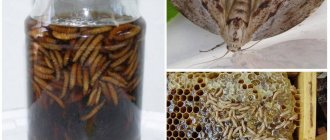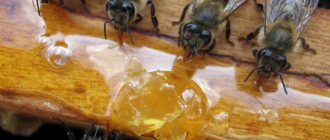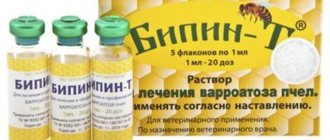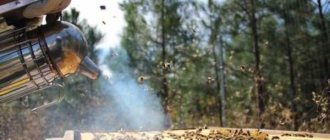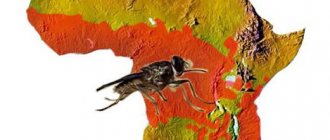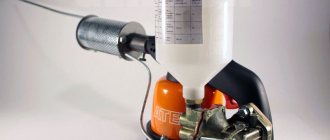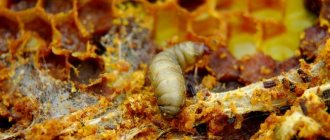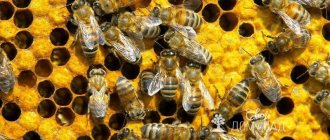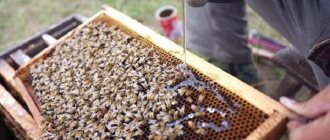The use of live bees and beekeeping products has repeatedly proven its effectiveness, receiving only positive feedback from patients. Treatment with bee stings is based on the therapeutic effect of the poison entering the human blood through the bee's sting.
The main factor influencing the effectiveness of apitherapy is the bite points, their location on the body and the number of areas that can be treated in one session. When starting this type of treatment, it is necessary to understand all its features, including indications for use.
Bee stinging - apitherapy
Apitherapy is a collective term that includes many different treatment methods. They use both live bees and their waste products: honey, propolis, royal jelly, wax, bee bread, bee venom and much more.
The content of the article
- Bee stinging - apitherapy
- Beneficial properties of bee venom
- What diseases are treated with bee stings?
- Features of bee stinging
- What treatment regimens for bites are used?
- Contraindications and possible dangers
These products can be used in their natural form; various preparations, ointments, tablets, and drops are made from them.
Among the types of apitherapy, stinging stands out. This method of treatment is one of the oldest. It was used back in Ancient Rus'. Apitherapy received scientific justification at the end of the 18th century, when scientists officially recognized that bee venom could be used for medicinal purposes.
The Russian founder was Professor Lukomskoy, who practiced bee stings in the treatment of rheumatism and gout. Science continues to actively develop; beekeeping products are constantly being studied in scientific laboratories around the world and in clinical practice.
Beneficial properties of bee venom
Despite its scary name, bee venom has a whole range of healing properties, which has the most beneficial effect on the human body. If used in small doses.
Starting from the point of the bee sting, capillaries expand, which then spreads throughout the body. There is a significant improvement in blood circulation, all human organs, tissues and cells receive more oxygen and nutrients and begin to function better.
Many patients note a rapid subsidence of disease symptoms during the treatment process, an increase in the period of remission in chronic diseases, and if it is followed by a relapse, then it proceeds more smoothly.
Under the influence of a bite and poison entering the blood:
- the adrenal glands are activated,
- heart function improves,
- the process of hematopoiesis is accelerated,
- the amount of bad cholesterol in the blood decreases,
- metabolism improves,
- The immune system's defenses against infectious diseases increase.
What diseases are treated with bee stings?
An indication for the use of stinging can be any disease associated with poor circulation. Among the indications, one can highlight those pathologies that are the result of problems in the cardiovascular system, joint diseases, which can be caused by insufficient saturation of tissues with vital substances.
Watch the video: Treatment with bee stings
Bee venom favors the process of reproduction of pituitary and adrenal hormones. Many hormones produced help reduce inflammatory processes, from which we can conclude that the indications for the use of this procedure are various inflammations, both external (skin) and internal.
On the Internet there are a huge number of positive reviews from people who have tried bee stings on themselves in the process of treating diseases.
All reviews and many years of medical practice show that the range of diseases for which treatment with bees is recommended is quite wide. Among them are:
- Multiple sclerosis;
- Varicose veins and trophic ulcers;
- Spinal hernia;
- Diseases affecting the central nervous system;
- Various pathologies of the cardiovascular system - hypertension, coronary heart disease;
- Post-stroke and post-infarction conditions;
- Neurodermatitis;
- Psoriasis and eczema;
- Gastritis;
- Alopecia;
- Immunodeficiency;
- Radioactive exposure;
- Thyrotoxicosis;
- Dependence on psychotropic drugs and many others.
Stinging helps restore appetite, increase immunity, reduce fatigue, and get rid of insomnia. This method of treatment is indicated for people who experience a decline in vitality and energy.
According to numerous reviews and long-term medical practice, bee stinging of various points of the human body allows the body to return tone and energy.
Treatment of diseases of the central nervous system
Pathologies of the central nervous system, especially multiple sclerosis, are treatable. Having a complex effect on the body (improving blood circulation, increasing appetite), bites help restore the functioning of the central nervous system, nourishing it with all the necessary elements.
There is a noticeable improvement in coordination of movement, a person’s physical capabilities and external sensitivity are restored, the reflex reaction is normalized, and other symptoms characteristic of diseases of the central nervous system disappear.
To influence the central nervous system, reduce pain, activate the functions of the adrenal cortex, restore immunity, and rehabilitate after a stroke, the stinging technique is used according to the scheme of N. Ioirish.
Treatment regimen by day:
A course of treatment requires 55 bees. At the end, you should take a break of 4 days and continue stinging by three bees every day for up to one and a half months. The entire course of treatment requires up to 200 bees.
Treatment of osteochondrosis and back diseases
One of the indications for the use of bee treatment is diseases of the spine. Most often it is arthrosis, osteochondrosis, hernia. Numerous reviews say that bee sting for spinal hernia and other back diseases is an effective procedure. Treatment with insect bites is carried out on problem areas and bioactive points of the spine, which are determined by the doctor. Usually they are located in close proximity to the sore spot.
Bee venom has an antispasmodic and warming effect, reduces pain. The beneficial effect on the circulatory system allows you to stop the development of spinal diseases and put them into remission.
Treatment of lumbosacral radiculitis is carried out according to a different scheme, when stinging is done twice a week for one and a half months. After a break of two months, the treatment is repeated. At the second stage of treatment, insect bites are given daily.
Treatment of varicose veins
Treatment of veins with bee venom has an effective effect that has no analogues. It is almost impossible to synthesize bee venom artificially, and it is also quite difficult to surpass the results obtained from it with the help of other medicinal and non-medicinal agents.
Stinging should only be prescribed by a doctor. He also determines those biologically active points at which the bees should bite the patient.
In parallel with bee stinging, other types of apitherapy are also recommended. It is very useful to consume at least one tablespoon of honey per day. Taken together, this treatment gives positive dynamics in the fight against varicose veins. Blood circulation improves and blood vessels dilate. The toxic secretion of bees affects blood clotting, the functioning of the valve apparatus of veins, and the walls of blood vessels.
Causes
- Degeneration or wear that leads to disc failure.
- Repetitive flexion (extension) and twisting movements, especially in combination. These movements have the greatest impact on the outer annulus fibrosus of the disc.
- Discs are most susceptible to injury in a sitting or bending position because pressure on the disc is shifted anteriorly and the vector of force forces the contents of the disc posterolaterally toward the thinner, weaker portion of the annulus fibrosus.
- Fall or injury such as a car accident.
- Repetitive stress injuries from overhead work or weightlifting.
- Genetic factors may, to a certain extent, contribute to the early development of degenerative changes in the discs (osteochondrosis).
- Smokers are more likely to develop early disc degeneration
- Infection (discitis)
Features of bee stinging
When prescribing a course of treatment, the doctor must take into account not only the condition of his patient, but also the age of the bee, which directly affects the composition of its venom. In medicine, there are specially developed methods that make it possible to understand what dose of poison is indicated for a patient of a given age suffering from a specific disease.
When do you need a veterinarian?
A veterinarian is needed if the dog’s condition worsens, the allergic reaction does not subside, and the dog’s breathing becomes heavy and intermittent. If it seems that the animal is suffocating, then you need to rush to a medical facility.
Important! At the slightest sign of anaphylaxis, you should immediately go to the veterinarian. After all, the pet's life is at risk.
Even if the animal behaves as usual and there are no changes in appearance, it is worth visiting a doctor if you are sure that it was stung in the neck or face. You cannot hesitate if your dog has swallowed a wasp. There is a possibility that the insect did not have time to sting him. But when the dog begins to whine pitifully and tears well up in his eyes, the visit to the clinic cannot be postponed.
What treatment regimens for bites are used?
- For hypertension, according to experts, the effective place for a bite is the lumbar region and the place behind the ears;
- For eye disease, effective bite points are in the temple area;
- For urinary incontinence in childhood, insects are applied to the abdomen (2.5 cm below the navel);
- For trophic ulcers, the bees are planted next to the wound, 5 centimeters away from it, taking into account the location of the nerve;
- For uterine fibroids, treatment of prostatitis and impotence associated with this disease is carried out by bee stinging of the popliteal area and the perineal area;
- If the functions of the thyroid gland are impaired, 4 insects are planted on both sides of it and two stings are made on the lower back.
- Treatment of arthritis and arthrosis of the joints is carried out by planting bees directly on the sore spot, 5-10 insects at a time. But there should not be more than 4 bites per joint. Stings are especially effective for gout and gouty arthritis. Full treatment requires up to 200 bees.
- For bronchial asthma, the collar area is affected, starting with four bites, one is added every day.
- When treating angina, bees are placed to bite the left shoulder and back (in the projection of the heart), up to 5 insects at once.
The bee sting procedure is quite specific and painful, so not everyone decides to try it on themselves, even despite the guaranteed positive effect.
There are many people who are terrified of bees and do not let them near them under any pretext. But lovers of these insects resort to apitherapy only as a last resort. As you know, a bee can sting only once in its life, after which it dies instantly.
Red flags for neck pain
A serious underlying cause is more likely in people who:
- The onset of symptoms appeared before the age of 20 years or after 55 years.
- Weakness involving more than one myotome or sensory disturbance involving more than one dermatome.
- Intense or increasing pain.
Red flags suggesting possible malignancy, infection or inflammation:
- Fever.
- Unexplained weight loss.
- History of inflammatory arthritis.
- A history of malignancy, drug abuse, tuberculosis, AIDS, or other infection.
- Immunosuppression.
- Pain that gets worse, is very intense and/or disturbs sleep.
- Lymphadenopathy.
- Local point tenderness over the vertebral body.
Red flags suggesting myelopathy (spinal cord compression):
- Progression of symptoms.
- Gait disturbance; weakness or impaired motor function in the hands; loss of bladder/bowel control.
- Lhermitte's sign (bending the neck causes an electric shock sensation that travels down the spine and into the extremities).
- Pathological symptoms in the lower extremities (Babinski reflex, hyperreflexia, clonus, spasticity) and in the upper extremities (atrophy, hyporeflexia).
- Various sensory changes (loss of proprioception more noticeable in the arms than in the legs).
Red flags indicating the possibility of severe skeletal injury:
- Trauma history.
- Previous neck surgery.
- Osteoporosis or risk factors for osteoporosis.
- Increase and persistence of pain.
Red flags indicating vascular insufficiency:
- Dizziness and darkening before the eyes (compression of the vertebral artery) when moving, especially when straightening the neck.
- Dizziness, syncope episodes.
